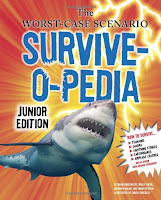Nonfiction Monday: The Worst-Case Scenario Survive-o-pedia
 The Worst-Case Scenario Survive-o-pedia
The Worst-Case Scenario Survive-o-pediaby David Borgenicht, Molly Smith, Brendan Walsh, and Robin Epstein
illustrated by Chuck Gonzales
ISBN: 978-0-8118-7690-2
Grades 3 and up
Reviewed from purchased copy.
Blurb:
It s the best of the worst! This hardcover, full-color edition of the popular series loved by parents and kids alike serves up a wild ride through mudslides, volcanoes, shark-infested oceans, menacing mountains, and more. Seventy entries are packed with illuminating facts, eye-popping photos, hilarious illustrations, must-see maps, heaps of humor, and step-by-step instructions. Readers will be armed with the knowledge and skills needed to survive anything and live to tell about it! (http://www.goodreads.com/book/show/11445223-the-worst-case-scenario-survive-o-pedia)The world around us is a fascinating place, but it can also be a dangerous place. Knowledge can often be the difference between life and death, maybe that is why I enjoy reading survival related books, but not actually experiencing adventures of that kind. I am not a very daring person. This last week I went floating a river for the first time (tube not raft) and I enjoyed it, but there were a couple of moments of panic. I am pretty sure that I would not do so well in true wilderness. Any way, this book intrigued me and I was curious to see the kind of advice it would give.
This book covers seventy different kinds of threats to human survival. Everything from natural disasters to wildlife encounters to different environmental dangers and human-caused dangers (plane crashes, mobs, etc.) For the most part the information is straight-forward and accurate. The reader needs to keep in mind however, that the advice contained in this book is very generic. Overall the information is helpful and encourages the use of common sense.
I did have a problem with one entry. The entry on Komodo Dragons is not completely accurate. First, Komodo Dragons are not the world's largest reptile (alligators and crocodiles can get much bigger, I just read an article today about a 21-foot long crocodile being caught in the Philippines). They are the world's largest LIZARD, however. In addition the authors describe Komodo dragons as being venomous, something that some scientists are disputing. Regardless of how Komodo dragons kill their prey (venom or bacteria or shock from ambush) there is no doubt that one really wouldn't want to be bitten by one.
The illustrations are great, gorgeous photographs mixed with cartoon-like drawings compliment the text in age appropriate ways. The book is not graphic in any way. The book would be great for reluctant readers and for teaching students about the importance of accuracy in nonfiction works. Recommended.
 Nonfiction Monday is a meme hosted each week highlighting nonfiction children's books. Today it is being hosted by Playing by the Book.
Nonfiction Monday is a meme hosted each week highlighting nonfiction children's books. Today it is being hosted by Playing by the Book.



Just 2 weeks ago there was a documentary on the BBC about how researchers now do believe the Komodo dragon is indeed venomous and its ability to kill prey is not down to bacteria, but rather it inject a blood thinner into its prey and this causes masses blood loss and thence death. Here's a page about the documentary: http://www.bbc.co.uk/nature/life/Komodo_dragon
ReplyDeleteI always find it fascinating to see science in action and how sometimes theories can be proven or disproved. Here's an article about the same study, http://www.signonsandiego.com/news/2009/may/25/1c25komodo183628-venom-may-be-boost-dragons-bite/?uniontrib. Here it sounds like not all biologists are convinced that venom is what kills the prey. Apparently, more work remains to be done. Thanks for your comment.
ReplyDelete